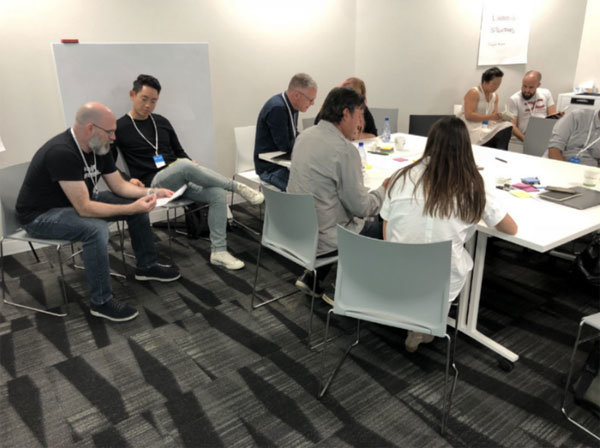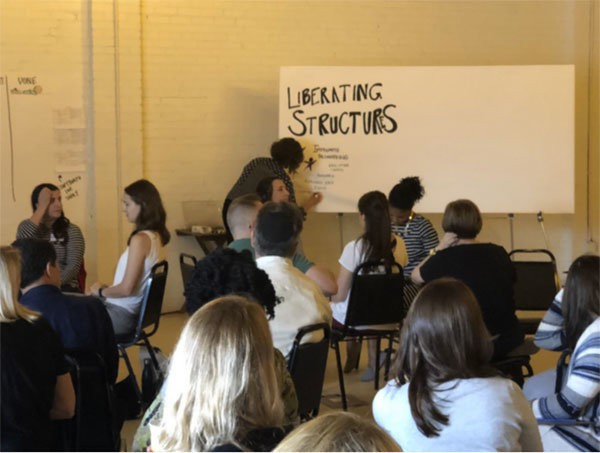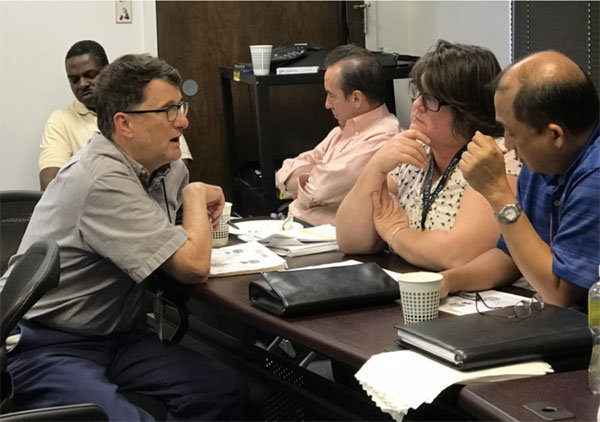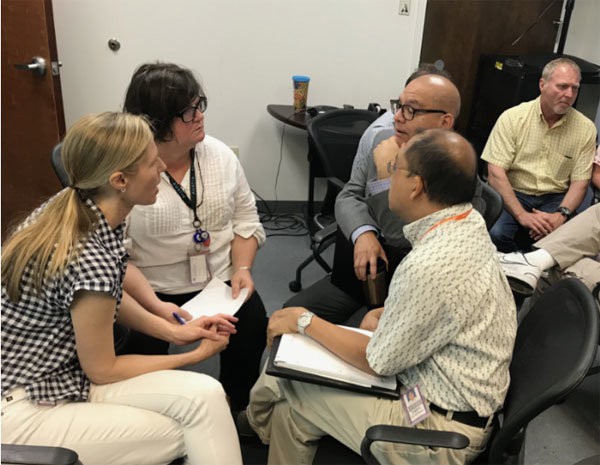Using Methods From Liberating Structures to Create a Robust Design Sprint Plan
MG RUSH welcomes Douglas Ferguson as an Endorsed Facilitator and Guest writer. Douglas is an expert in Design Sprints and how to facilitate a Design Sprint Plan. He is highly regarded for start-up inspired strategies and innovation transformation. A proven and successful CTO in his past life, Douglas has a passion for helping organizations solve tough problems through powerful group decision-making methods. Douglas prioritizes the human aspects of any challenge, believing that innovation is driven by listening to users and uncovering diverse perspectives.
This is part of Douglas’ workshop recipe series where he shares methods for facilitating successful workshops. Here he breaks down the essentials of a Liberated Design Sprint Plan. This article originally appeared on voltagecontrol.com. (Reprinted here with Douglas Ferguson’s permission)
Planning is critical for a successful Design Sprint. In fact, I wrote an article with tips on how to plan a successful Design Sprint. When building an agenda, it’s helpful to get stakeholders together in a structured manner to create an effective plan.
This planning recipe is designed using Liberating Structures (LS) to accommodate a large group of stakeholders and still result in a concise and cohesive plan for your Sprint.
Liberating What?
Liberating Structures is a menu of 33 activities or “microstructures” that you can use in meetings or workshops. It was created by Henri Lipmanowicz and Keith McCandless.

Recommended Liberating Structures for a Design Sprint Plan
9 Whys for a Design Sprint Plan Goal | 20 mins
What it is: The 9 Whys is an activity to help you quickly reveal a compelling purpose and move forward with clarity.
Why we use it: It helps clients articulate their Design Sprint goal.
Method Steps
- Craft an opening question using the template “What do you do when working on ____” or something custom.
- Break the group into pairs.
- Each pair selects one person to be the interviewer.
- First, the interviewer asks the opening question.
- Next, the interviewer seeks a deeper answer by repeating versions of the question: “Why is that important to you?” 5min
- After 5 minutes, switch roles and repeat the previous step.
- Each pair shares the experience and insights with another pair in a foursome. 5min
- Invite the whole group to reflect by asking, “How do our purposes influence the next steps we take?” 5 min.
Wicked Questions | 25 min
What it is: Wicked Questions is an activity designed to reveal organizational challenges.
Why we use it: I use this method to uncover some of the key tensions that our Design Sprint will reveal.
Method Steps
- Introduce the benefits of Wicked Questions.
- Present example questions such as, “How is it that you are raising your children to be very loyal/attached to the family and very independent individuals simultaneously?
- Introduce the following template: “How is it that we are … and we are … simultaneously?” 5 min.
- Have each participant generate pairs of opposites at play in his/her work using the format. 5 min.
- In small groups, generate additional pairs of opposites at play. 5 min.
- Each group selects its most impactful Wicked Question. 5 min
- Share back with the whole group. 5 min.
- The group picks out the most powerful questions and further refines them. 10 min.
Ecocycle Planning | 95 min
What it is: Ecocycle Planning is where you review and prioritize all of your current initiatives.
Why we use it: It gets everyone on the same page before the Sprint about initiatives in-flight, as well as what is and isn’t working.
Method Steps
- Introduce the idea of the Ecocycle.
- Hand out a blank map to each participant. 5 min.
- Participants generate individual activity lists: “For your working group or department, make a list of all the activities that occupy your time.” 5 min.
- Work in pairs to decide the placement of every activity in the Ecocycle. 10 min.
- Form groups of four and finalize the placement of activities on the map. 15 min.
- Each group puts its activities on Post-it notes. Create a whole-room map by having all of the groups place their Post-its on a larger map. 15 min.
- Instruct the group to step back and digest the pattern of placements. 5 min
- Ask: “What activities do we need to stop to move forward? What activities do we need to start to move forward?” 10 min.
- In small groups, create a first action step for each activity that needs to be stopped. (10 min. or more)
- In small groups, create a first action step for each activity that needs to start (10 min. or more)
- Ask the groups to quickly discuss the activities that lack consensus. When possible, create first-action steps for each one. 10 min.
Purpose to Practice | 120 min
What it is: Purpose to Practice is an activity to help a group create their shared purpose.
Why we use it: It helps us define five essential elements before a Sprint: purpose, principles, participants, structure, and practices.
Method Steps
- Introduce Purpose to Practice by explaining that the group will explore five elements: Purpose, Principals, Participants, Structure, Practices
- Hand out blank worksheets. 5 min.
- Begin with purpose by asking, “Why is the work important to you and the larger community?”
- Use 1–2–4 All to generate individual ideas and stories for purpose. (1–2–4-All refers to working alone, then in pairs, then foursomes, and finally as a whole group.) 10 min.
- Ask, “Has this element shed new light that suggests revisions to previous elements?” 5 min.
- For principles, ask: “What rules must we absolutely obey to succeed in achieving our purpose?”
- Use 1–2–4 All to generate, amplify, and finalize ideas for principles.10 min.
- Ask, “Has this element shed new light that suggests revisions to previous elements?” 5 min.
- For participants, ask: “Who can contribute to achieving our purpose and must be included?”
- Use 1–2–4 All to generate, amplify, and finalize ideas for participants.10 min.
- Ask, “Has this element shed new light that suggests revisions to previous elements?” 5 min.
- For structure ask: “How must we organize (both macro- and microstructures) and distribute control to achieve our purpose?”
- Use 1–2–4 All to generate, amplify, and finalize ideas for structure.10 min.
- Ask, “Has this element shed new light that suggests revisions to previous elements?” 5 min.
- For practices, ask: “What are we going to do? What will we offer to our users/clients and how will we do it?”
- Use 1–2–4 All to generate, amplify, and finalize ideas for practices.10 min.
- Ask, “Has this element shed new light that suggests revisions to previous elements?” 5 min.
Critical Uncertainties That Might Upset a Design Sprint | 100 min
What it is: Critical Uncertainties is a way to reveal the issues that are both fundamental to success, but also full of unknowns.
Why we use it: It helps us understand some of the biggest questions and challenges a group has coming into a Sprint.
 Method Steps
Method Steps
- Invite participants to make a list of uncertainties by asking, “In your work, what factors are impossible to predict or control?” 5 min.
- Prioritize these factors by asking, “Which factors threaten your/our ability to operate successfully?” 10 min.
- From that list pick the top 2 factors that are both critical and uncertain. 5 min.
- Create a grid with two axes, for your 2 top factors ( X & Y).
- Label one end of both axes with a “more of X/Y”
- Label the opposite end of both axes with a “less of X/Y”
- Four quadrants are created. 5 min.
- Each of the groups creatively names and writes a short description for one of the quadrants. 10 min.
- The groups share their names & descriptions. 2 min. each
- Each group brainstorms three strategies that would help the group operate successfully in the scenario. 10 min.
- The four groups share their strategies briefly. 2 min. each
- The whole group identifies which strategies are robust (strategies that can succeed in multiple quadrants) and which are hedging (strategies that can succeed in only one scenario but protect you from a plausible calamity). 10 min.
- Each small group debriefs with What, So What, Now What? 10 min.
- The four groups share their debriefs and the whole group makes first-steps decisions about their Now What. 10 min.
What, So What, Now What? | 45 min
What it is: What, So What, Now What? helps groups reflect on a shared experience.
Why we use it: It gets many key issues on the table before jumping into a Sprint.
Method Steps
- Individuals write down observations stood out. 1 min.
- In a small group discuss observations for 2–7 min.
- Small groups share with the whole group 2–3 min.
- Capture the important WHATs on a whiteboard.
- Individuals write down patterns, hypotheses, and conclusions. 1 min
- In a small group discuss patterns, hypotheses, and conclusions 2–7 min.
- Small groups share with the whole group. 2–5 min.
- Capture the important SO WHATs on a whiteboard.
- Individuals write down next steps 1 min.
- In a small group discuss next steps 2–7 min.
- Small groups share with the whole group. 2–10 min.
- Capture the important NOW WHATs on a whiteboard.
These are six Liberating Structures that Douglas has found useful to use with clients when planning a Design Sprint. Have other activities or methods that you like to leverage? Let us know!
______
Don’t ruin your career or reputation with bad meetings. Therefore, register now for a class or forward this to someone who should. Taught by world-class instructors, MG RUSH professional facilitation curriculum focuses on practice. Each student thoroughly practices and rehearses tools, methods, and approaches throughout the week. While some call this immersion, we call it the road to building impactful facilitation skills. #meetingresults
Our courses also provide an excellent way to earn up to 40 SEUs from the Scrum Alliance, 40 CDUs from IIBA, 40 Continuous Learning Points (CLPs) based on Federal Acquisition Certification Continuous Professional Learning Requirements using Training and Education activities, 40 Professional Development Units (PDUs) from SAVE International®, as well as 4.0 CEUs for other professions. (See individual class descriptions for details.) #facilitationtraining
Want a free 10-minute break timer? Signup for our once-monthly newsletter HERE and receive a timer along with four others of our favorite facilitation tools, free. #meetingdesign
______
With Bookmarks no longer a feature in WordPress, we need to append the following for your benefit and reference
- 20 Prioritization Techniques = https://foldingburritos.com/product-prioritization-techniques/
- Creativity Techniques = https://www.mycoted.com/Category:Creativity_Techniques
- Facilitation Training Calendar = https://mgrush.com/public-facilitation-training-calendar/
- Liberating Structures = http://www.liberatingstructures.com/ls-menu
- Management Methods = https://www.valuebasedmanagement.net
- Newseum = https://www.freedomforum.org/todaysfrontpages/
- People Search = https://pudding.cool/2019/05/people-map/
- Project Gutenberg = http://www.gutenberg.org/wiki/Main_Page
- Scrum Events Agendas = https://mgrush.com/blog/scrum-facilitation/
- Speed test = https://www.speedtest.net/result/8715401342
- Teleconference call = https://youtu.be/DYu_bGbZiiQ
- The Size of Space = https://neal.fun/size-of-space/
- Thiagi/ 400 ready-to-use training games = http://thiagi.net/archive/www/games.html
- Visualization methods = http://www.visual-literacy.org/periodic_table/periodic_table.html#
- Walking Gorilla = https://youtu.be/vJG698U2Mvo
Douglas Ferguson is an entrepreneur, facilitator, and human-centered technologist with over 20 years of experience. He is president of Voltage Control, an Austin-based workshop agency that specializes in Design Sprints and Innovation Transformation. He is also an MG RUSH Certified and Endorsed Professional Facilitator.








Nice blog, thanks for sharing
Thanks kindly Mirketa, We’d like to claim that there are another few hundred articles, many with other valuable tools, worth perusing as well.